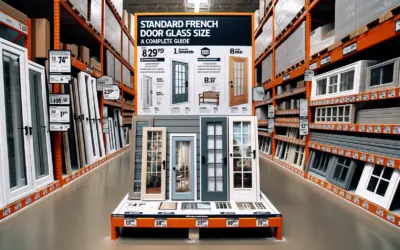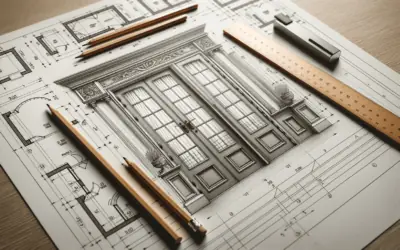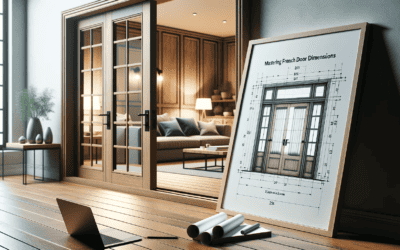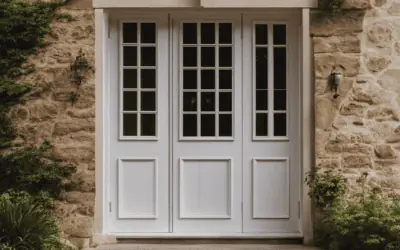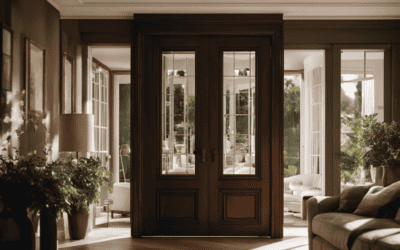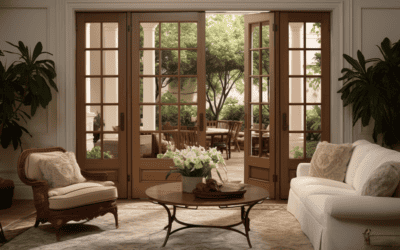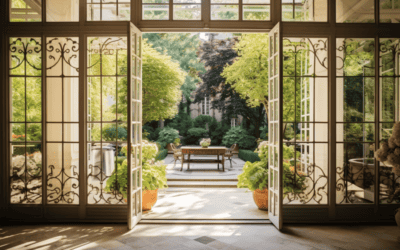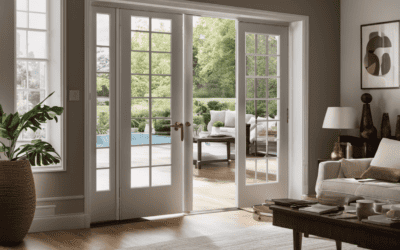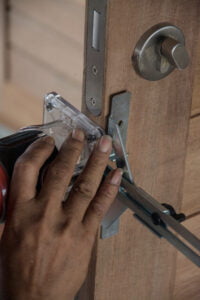 Yes, it is possible to change the opening direction of French doors. However, the task involves more than just reversing the door. The frame must be removed and reversed to accommodate the new opening direction, which requires remortising the hinges to face the other way. Additionally, it would help if you moved the astragal to the other side of the door. You may even need to purchase a new door for an outward swing.
Yes, it is possible to change the opening direction of French doors. However, the task involves more than just reversing the door. The frame must be removed and reversed to accommodate the new opening direction, which requires remortising the hinges to face the other way. Additionally, it would help if you moved the astragal to the other side of the door. You may even need to purchase a new door for an outward swing.
Quick tips:
- French door opening direction can be changed.
- Reversing the door is not enough, and the frame must be removed and reversed.
- Hinges need to be remortised to face the opposite direction.
- Astragal (the weather stripping on the active door) must be moved to the other side.
- The outward swing may require purchasing a new door.
Why Do French Doors Open Outwards?
French doors typically open outwards for various advantages, both aesthetically and functionally. Outward-opening French doors offer benefits such as improved ventilation, which allows for more natural light and an unobstructed view of the outside scenery. Additionally, these doors are less prone to damage from strong winds or snow buildup, providing superior protection against the elements compared to inward-opening French doors.
Furthermore, the wider opening capacity of outward-opening French doors adds to its appeal. Although inward-opening French doors may offer some advantages in terms of protection from the elements and better control over airflow, they are less common due to the clear advantages of outward-opening models.
Can You Switch Active Door On French Doors?
Yes, switching the active door on French doors is possible, but it depends on your doors’ specific model and construction. If your French doors are equipped with handles, the easiest solution would be to switch the centre mullion, effectively changing one of the doors from active to inactive.
However, if your French doors do not have handles, it would be necessary to install two sets of handles to make this change. Some side-by-side patio French doors may come in both active operations and as a combination of an active/inactive pair, making purchasing a new door a more suitable option.
Which Door Opens First On French Doors?
When installing French doors in a home, the door that opens first from the exterior is determined by the “handing” of the unit. It is generally recommended to have a single door opening outwards. If you have double French doors, it is typical for the left one to open first from the exterior of the home.
However, the opening direction of French doors can be adjusted based on personal preference, with options for opening inwards or outwards. There are two types of handing on French doors: Left Hand Reverse (LHR) and Right Hand Reverse (RHR). You can easily switch which door opens first by choosing between these two settings.
Consulting with a professional carpenter or contractor is highly recommended to determine the best handing type for your situation. They should take into consideration your overall needs and ensure that all components, including hardware components such as hinges, locks, and handles, work together as intended.
When dealing with multiple-part units like double French doors, it is essential to create a balanced lead for smooth operation from both sides. This also includes keeping in mind hardware differences between manufacturers when deciding which door will swing.
Do Both Doors Open On French Doors?
Yes, both doors open on French doors. These doors are made up of two hinged panels, or “leaves”, which can be opened from the centre. The two leaves offer flexibility, as they can both be opened together or separately depending on the desired airflow or width needed for a particular opening. Double doors are often used in this style as well.
French doors are designed to provide a wide opening when both leaves are opened parallel to each other and provide an airtight seal when closed. They often include a locking mechanism, such as keys, deadbolts and multiple-point locks, for extra safety and security options.
Which Way Do French Doors Open?
Overall, French doors open outwards. This is the most common installation, as it is designed to let fresh air and light into a room while maximizing space in the garden. Outward opening offers better ventilation due to the larger openable area.
However, there are times when inward opening can be a better option for improved security and hiding the hinges inside your home. If space is limited in the garden or you prefer more security, then inward-swinging French doors may be a good choice. The inward opening also allows minimal effort to open the doors inside your home.
Before purchasing, it is important to decide which direction you would like your French door to swing and to get an estimate for installation costs. Professional carpenters will survey the doors before installing to ensure that your chosen direction does not cause any interference with other features, such as furniture or window frames.
Is It Better To Have French Doors Open In Or Out?
It depends on the homeowner’s preference, the home’s layout, and the door’s purpose. Outswing doors are more secure and better suited for exterior installation as they protect against intruders trying to get in. Inswing doors are typically better for interior applications as they prevent obstructions in tight spaces like hallways.
An outswing patio door is becoming increasingly popular among homeowners wanting to maximize their indoor space. It eliminates potential interior door obstructions and can significantly enhance living space. Opening the door outwards enhances the indoor space and eliminates any potential obstructions.
Ultimately, deciding between having French doors open in or out is up to the homeowner’s preference and specific application, considering their unique environment, including weather. It is important to consider desired results that will satisfactorily maximize both security and comfort levels within the home.
Change French Doors To Open Out?
Changing the direction of the opening for French doors from inswing to outswing is possible but requires effort. Installing the doors backwards is the easiest way. Still, for security reasons, there may be better options than this, as the lockset would then be on the exterior side, putting the home at risk.
To change a French door from inswing to outswing, the first step is to remove it from its hinges. Then, you must adjust the hinge plate by tightening or loosening screws until it fits snugly on the jamb, without sticking out too far or being too shallow in either direction.
Once you have secured the hinge plate in place, rehang the door inside-out for an outward swinging motion, and relocate the astragal to match, which should also be attached securely with screws or nails.
Before painting and repairing any damage caused by removing and rehanging the French door, it is important to account for issues such as creaking joints or scratches that may require caulking or filling to keep the door functional up-to-code with safety regulations.
Therefore, converting an inswing French door to an outswing is feasible as long as you are meticulous with proper measurements and are willing to undertake repairs afterwards.
Can You Get Tilt And Turn French Doors?
Yes, you can get tilt and turn French doors. These doors are designed with side hinges that allow for an inward opening to various degrees, providing flexibility in ventilation options. By tilting the door slightly or turning it 90° using the side hinges, they can be completely flush with the wall, allowing you to balance ventilation and security without compromising on safety.
Overall, tilt-and-turn French doors are an excellent choice for providing both convenience and adequate ventilation in your home. However, to ensure proper installation and optimal functionality, a professional carpenter must have the technical knowledge and expertise.
Additional information:
How To Replace French Door Hinges?
 Replacing French Door Hinges is a fairly simple but technical process that requires precision and proper knowledge. Here are the steps to correctly replace French door hinges:
Replacing French Door Hinges is a fairly simple but technical process that requires precision and proper knowledge. Here are the steps to correctly replace French door hinges:
Step 1. Measure and mark the location of the door frame where the door hinge needs to be replaced.
Step 2. Trace around the hinge with a pencil or marker to outline its approximate size and shape.
Step 3. Using a woodcutting chisel or saw, cut a mortise—a shallow recess—within the outlined shape on each side of the door frame to fit the hinge securely.
Step 4. Mark exactly where screws need to be located to secure each side of the door hinge firmly before drilling any pilot holes.
Step 5. Drill pilot holes through both parts of the frame that will receive screws with an electric drill or powered screwdriver to prevent wood end splitting and facilitate easy installation.
Step 6. Install each door hinge onto one part of the door frame – either side – at once, making sure they match up evenly and do not hang off-centre or crease upon closing; then connect either side firmly together using 3-inch screws and ensure they hold securely in place without shifting when opened or closed multiple times (for instance, by hanging something heavy from it).
Step 7. Test how well your finished product works, such as by opening & closing it several times before finally setting aside tools & completing the job & being done!
Step 8. To remove an existing French door hinge is relatively straightforward yet needs careful attention when dealing with nails/screws on either jamb-side that can loosen upon removal attempts: use a flat-head screwdriver & hammer to tap out the pin holding them together until loose enough to take out (carefully), OR pry upward gently with a claw hammer between nails/screws if needed (& replace accordingly); also keep this in mind when reattaching hinges too, so both sides remain level & have as few gaps as possible between them without overly straining/bending either part separately).
Lastly, if necessary, when replacing an entire doorframe itself, due diligence must be taken while using 2×4 planks of lumber cut into desired measurements based on current door measurement dimensions; use carpentry nails or 3-inch screws for extra support & stability depending on downsize’s angle that needs reinforcement purposes during construction setup stages).
Tools Required to Change a Door Hinge:
How To Adjust French Door Latch?
French doors often require adjustment of their latch due to the normal warping of the doors over time. Proper adjustment of your French door latch ensures that it closes securely, providing peace of mind that it won’t come loose or open unexpectedly. To properly adjust the top latch on your French doors, follow these steps:
Step 1. Close the door and check if the top latch shuts cleanly. If it does, this indicates that the door has warped slightly, which is a regular occurrence over time with French doors.
Step 2. Remove any nails from the doorstop or jamb, then open both doors fully and use a prop, such as a folding chair, to keep them open while you work on the French doors.
Step 3. Unscrew all screws holding the threshold in place before lifting it off entirely. Caulk any gaps between the frame and threshold before replacing the threshold afterwards.
Step 4. Pull out pins from either side of your French doors and turn these clockwise to increase contact pressure or anticlockwise to reduce contact pressure for both panels as necessary to make them fit snugly against each other when closed.
Step 5. For raising or lowering an individual panel, start with its top hinge. Then, using a ¼ inch allen key, rotate its bolt clockwise to raise it up or counterclockwise to lower it down until you achieve the desired gap of 0 (snug fit) between the two panels when closed.
Step 6. Check if there is still any gap between your French door panels when they are joined together after making all necessary adjustments. If there’s still a gap, repeat these steps until it is eliminated entirely and a snug fit is achieved.
Tools Needed to Replace a Door Latch:
– Cross tip or Phillips head screwdriver
– Flat head screwdriver (optional)
– Appropriate hardware for new door locks (purchased separately)
How To Install A New Handle On French Doors?
Installing a new handle on French doors is a relatively simple process that requires some essential tools and basic knowledge of carpentry techniques. The following steps will help you install a new handle on your French doors:
Step 1: Determine which side will be the active handle by locating the lock cylinder pin on the door edge and marking it for drilling.
Step 2: Use a drill and hole saw to bore two holes into each door; one for the lock cylinder and one for the actuator slot.
Step 3: Insert the actuator slot into one of the pre-drilled holes in each door and then slide in the spindle into the spindle hole.
Step 4: Slide the new handle into each door, ensuring they are pointing towards the glass. Secure it by inserting a screwdriver and tightening down the set screws on both handles’ undersides.
Following these steps, you can successfully install your new handle onto French doors. Check for proper fit before closing the doorway, and enjoy the updated look!
Tools required for changing a door handle:
– Wood block and hammer (for drive-in latch)
– Regular socket and ratchet set (if needed to remove exterior door handle)
Related Articles:
Charm and Elegance Unleashed: The Timeless Appeal of Timber French Doors
Timber French doors are a timeless architectural element that grace homes with elegance, natural warmth, and beauty. With their characteristic large glass panels surrounded by wide stiles and rails made of solid wood, these doors create an inviting transition between...
French Doors Buying Guide: An In-Depth Look
French doors are a popular choice for homeowners looking to enhance natural light, ventilation, and aesthetic appeal. With their characteristic large glass panes and narrow dividing frames, these elegant doors create an inviting indoor-outdoor flow. This comprehensive...
Standard French Door Glass Size: A Complete Guide
French doors are an elegant and timeless architectural feature known for their decorative glass panes that allow ample natural light into a space. But what are the standard glass sizes for these iconic doors? Understanding the typical dimensions of French door glass...
How Big Can French Doors Be in CM? A Complete Guide
French doors are a classic and elegant addition to any home. With their large glass panes and delicate dividers, they allow ample natural light into a space while providing a beautiful architectural focal point. But before installing these iconic doors, it's important...
Mastering French Door Dimensions: Your Ultimate Guide to Exterior Sizes
French doors are a classic and timeless architectural feature that can add elegance, charm and functionality to a home. As their name suggests, they originated in France but have been popular in the US and elsewhere for over a century. I'm a homeowner looking to...
What Are Active or Stationary French Doors
Welcome to our guide on active and stationary French doors! Picture this: you're standing in your home, longing for elegance and functionality. That's where French doors come in. These beauties consist of two door panels, one that swings open (the active side) and one...
How to Stop French Doors Slamming
French doors constantly slamming shut, causing frustration and potential damage? We've got you covered. With some maintenance and simple adjustments, you can prevent your doors from slamming and enjoy their beauty and functionality for years. Regular inspection and...
From Classic to Contemporary: The Impact of French Doors on Modern Architectural
Discover the impact of French doors on modern architectural design. From classic elegance to seamless indoor-outdoor flow, unlock the beauty of contemporary living.
The Architectural Impact of French Doors: A Historical Perspective
Discover the architectural influence of French doors! From Europe to America, their impact on design is unparalleled.
French Door Sizes: A Complete Guide to Standard and Custom Dimensions
As I step through the threshold of knowledge, let me guide you through the world of French door sizes. This comprehensive article explores the standard dimensions for exterior and interior French doors and the exciting possibilities of custom sizes. I'll also reveal...



